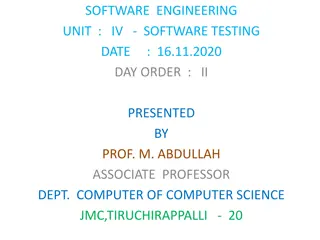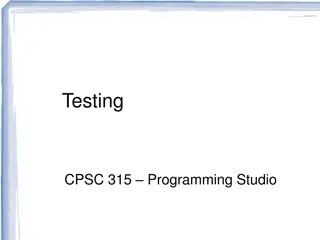Understanding Testing in Software Engineering
In the previous session, we discussed various aspects of software engineering, including modeling with UML diagrams, such as activity diagrams, use case diagrams, sequence diagrams, state diagrams, and class diagrams, as well as architecture patterns. Testing was emphasized as a key aspect, highlighting that testing can reveal errors but not their absence. Different types of testing were explored, such as validation testing and defect testing, with an emphasis on the importance of distinguishing between the two. The stages of testing in commercial software systems were also covered, including development testing, release testing, user testing, and acceptance testing.
Download Presentation

Please find below an Image/Link to download the presentation.
The content on the website is provided AS IS for your information and personal use only. It may not be sold, licensed, or shared on other websites without obtaining consent from the author. Download presentation by click this link. If you encounter any issues during the download, it is possible that the publisher has removed the file from their server.
E N D
Presentation Transcript
What did we talk about last time? Software engineering Modeling and UML Activity diagrams Use case diagrams Sequence diagrams State diagrams Class diagrams Architecture patterns
Testing can only show the presence of errors, not their absence. Edsger Dijkstra Historically, testing has sometimes been a task given to junior developers As systems have gotten more complex, people have gotten more excited about testing Finding ways to test subtle aspects of a program can be a rewarding challenge
There are two almost opposing purposes for testing Showing that software meets its requirements Validation testing Looking for good outputs Finding inputs where software doesn't work Defect testing Looking for bad outputs When a project is due, students often confuse the two Trying to convince themselves that the code is fine instead of looking for problems
Commercial software systems often go through three stages of testing Development testing Look for bugs during development Designers and programmers do the testing Release testing Test a complete version of the code to see if it meets requirements A separate testing team does the testing User testing Users test the system in a real environment Acceptance testing is a special kind of user testing to decide whether or not the product should be accepted or sent back
Development testing is the idea of testing you're most familiar with Testing the software as it's being developed Development testing is focused on defect testing Debugging happens alongside development testing Three stages of development testing: Unit testing: testing individual classes or methods Component testing: testing components made from several objects System testing: testing the system as a whole
Unit testing focuses on very small components Methods or functions Objects Unit tests try many different inputs for the methods or objects to make sure that the outputs match
Broken method to determine if a year is a leap year: public static boolean isLeapYear(int year) { return year % 4 == 0 && year % 100 != 0; } Tests: isLeapYear(2016) true (correct) isLeapYear(2018) false (correct) isLeapYear(1900) false (correct) isLeapYear(2000) false (incorrect)
Because unit tests are based on simple relationships between input and expected output, they can usually be automated And they totally should be Automated tests have three parts: Setup: initialize the system with the inputs and expected outputs Call: call the method you're testing Assertion: compare the real output with the expected output
You can create unit tests by hand and run them However, the problem is so universal that many automated testing frameworks have been created The most famous for Java is JUnit Wikipedia lists about 50 just for Java Some have special strengths, like creating mock objects that behave in ways that are useful for testing These testing frameworks make it easier to generate and run the tests
Effective tests will show: When used as expected, a component does what it's supposed to Defects, if there are any, in a component In testing terminology, these are called positive tests (showing that stuff works) and negative tests (trying to make things crash) It's hard to pick good test cases
Two strategies for picking test cases: Partition testing Identify groups of inputs that will be processed in the same way Pick representatives from each group Guideline-based testing Use guidelines to choose test cases Guidelines are based on experience about the kinds of errors that programmers often make
Partition testing is based on the observation that programs often behave similarly for all members of a set of values Such a set is called an equivalence partition You can try to find a set of equivalence partitions that covers all behaviors
When dealing with sequences, arrays, and lists, consider: Testing software with sequences that have a single value (or no values) Use sequences of different sizes in different tests Design tests that access the first, middle, and last elements of a sequence
One philosophy of testing is making black box tests A black box test takes some input A and knows that the output is supposed to be B It assumes nothing about the internals of the program, only the specification To write black box tests, you come up with a set of input you think covers lots of cases and you run it and see if it works In the real world, black box testing can easily be done by a team that did not work on the original development
White box testing is the opposite of black box testing Sometimes white box testing is called "clear box testing" In white box testing, you can use your knowledge of how the code works to generate tests Are there lots of if statements? Write tests that go through all possible branches There are white box testing tools that can help you generate tests to exercise all branches Which is better, white box or black box testing?
Beyond unit testing is component testing Components are made up of several independent units The errors are likely to be from interactions between the units Hopefully, the individual units have already been unit tested The interfaces between the units have to be tested Parameter interfaces in method calls Shared memory interfaces Procedural interfaces in which an object implements a set of procedures Message passing interfaces
System testing is when we integrate components together in a version of the whole system Though similar to component testing, there are differences: Older reusable components and commercial components might be integrated with new components Components developed by different teams might be integrated for the first time Sometimes, you only see certain behavior when you get everything together Try testing all the use cases you expect the system to see
JUnit is a popular framework for automating the unit testing of Java code JUnit is built into Eclipse and many other IDEs It is possible to run JUnit from the command line after downloading appropriate libraries JUnit is one of many xUnit frameworks designed to automate unit testing for many languages You are required to make JUnit tests for Project 4 JUnit 5 is the latest version of JUnit, and there are small differences from previous versions
For each set of tests, create a class Code that must be done ahead of every test has the @BeforeEach annotation Each method that does a test has the @Test annotation import org.junit.jupiter.api.*; public class Testing { private String creature; } @BeforeEach public void setUp() { creature = "Wombat"; } @Test public void testWombat() { Assertions.assertEquals("Wombat", creature, "Wombat failure"); }
An assertion is something that must be true in a program Java (4 and higher) has assertions built in You can put the following in code somewhere: String word = "phlegmatic"; assert word.length() < 5 : "Word is too long!"; If the condition before the colon is true, everything is fine If the condition is false, an AssertionError will be thrown with the message after the colon Caveat: The JVM normally runs with assertions turned off, for performance reasons You have to run it with assertions on for assertion errors to happen You should run the JVM with assertions on for testing purposes
When you run a test, you expect to get a certain output You should assert that this output is what it should be JUnit 5 has a class called Assertions that has a number of static methods used to assert that different things are what they should be Running JUnit takes care of turning assertions on The most common is assertEquals(), which takes the expected value, the actual value, and a message to report if they aren't equal: assertEquals(int expected, int actual, String message) assertEquals(char expected, char actual, String message) assertEquals(double expected, double actual, double delta, String message) assertEquals(Object expected, Object actual, String message) Another useful method in Assertions: assertTrue(boolean condition, String message)
We know that the substring() method on String objects works, but what if we wanted to test it? import org.junit.jupiter.api.*; public class StringTest { } @Test public void testSubstring() { String string = "dysfunctional"; String substring = string.substring(3,6); Assertions.assertEquals("fun", substring, "Substring failure!"); }
What if a method is supposed to throw an exception under certain conditions? It should be considered a failure not to throw an exception The Assertions class also has a fail() method that should never be called import org.junit.jupiter.api.*; public class FailTest { @Test public void testBadString() { String string = "armpit"; try { } catch(NumberFormatException e) {} } } int number = Integer.parseInt(string); Assertions.fail("An exception should have been thrown!");
Imagine you've got a method with the following signature that can determine whether or not a String is a palindrome Assume it's a sophisticated function that ignores case and punctuation public static boolean isPalindrome(String phrase) What are good tests for it? Let's write at least four JUnit tests for it, covering cases when phrase is a palindrome and when it isn't
Consider the following Complex class, for holding real and imaginary numbers public class Complex { final double real; final double imaginary; public Complex(double real, double imaginary) { this.real = real; this.imaginary = imaginary; } public double getReal() { return real; } public double getImaginary() { return imaginary; } }
Let's make a quadratic() method that returns an array of Complex objects that are the roots of the quadratic equation ??2+ ?? + ? public static Complex[] quadratic(double a, double b, double c) { // Fill in code } Now, let's test it! What are good test cases?























